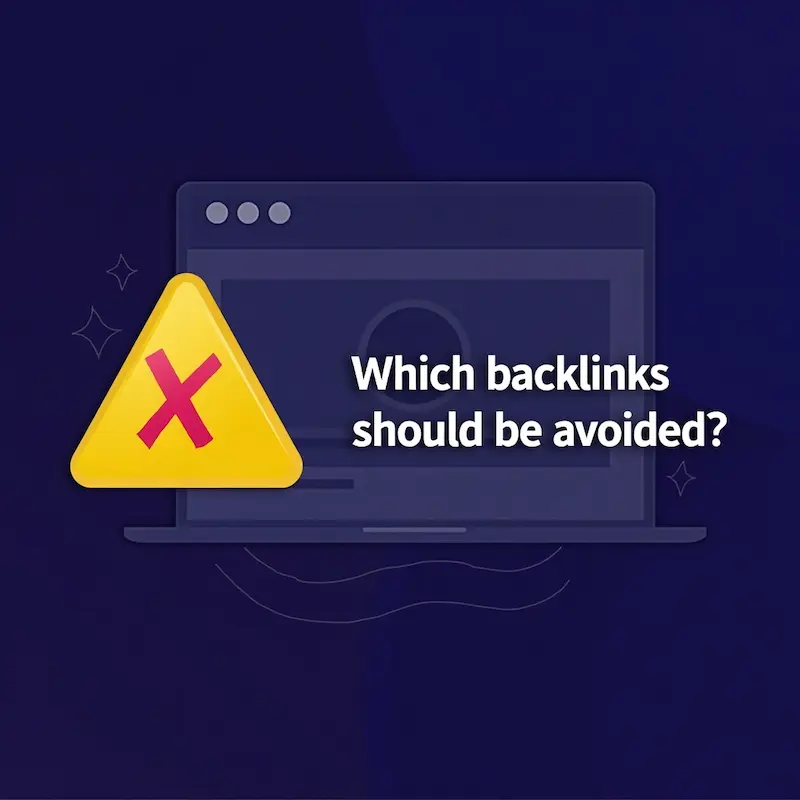Which backlinks should be avoided?

You’ve spent months building your website, crafting top-notch content, and optimizing every little SEO detail. Then—bam!—your rankings drop overnight. What happened? Chances are, bad backlinks are lurking in your profile like termites in a wooden house.
Not all backlinks are created equal, and some can seriously damage your site’s credibility. In this guide, we’ll break down which backlinks to avoid, why they’re harmful, and how to keep your site in Google’s good graces.
What Are Toxic Backlinks?
Toxic backlinks are links that violate Google’s guidelines, potentially leading to penalties or ranking drops. Instead of boosting your authority, these links act as red flags, signaling search engines that your site might be trying to game the system.
Think of backlinks as references on a resume—if they come from shady sources, they’ll hurt your reputation rather than help it.
Which Backlinks Should Be Avoided?
1. Paid Links
Buying backlinks is like buying fake followers—Google isn’t fooled. If a link is placed solely because money changed hands (without proper disclosure using a rel=”sponsored” tag), it violates Google’s policies.
🔴 Why Avoid? Google penalizes sites that engage in link schemes, potentially wiping out your organic traffic.
✅ What to Do Instead? Focus on earning natural links through quality content and genuine relationships.
2. Links from Private Blog Networks (PBNs)
PBNs are networks of websites created solely for link-building. While they may seem like a quick win, Google’s algorithm is getting smarter at detecting them.
🔴 Why Avoid? Google de-indexes PBNs frequently, meaning your backlinks can disappear overnight—taking your rankings with them.
✅ What to Do Instead? Build organic backlinks through guest blogging and networking with legitimate sites.
3. Spammy Blog Comments
Ever seen a blog post with comments like, “Great post! Check out my site for the best deals on weight loss pills”? That’s a classic example of spammy link-building.
🔴 Why Avoid? Google ignores these links, and too many can make your site look suspicious.
✅ What to Do Instead? Engage in meaningful discussions on relevant blogs—without dropping a sketchy link.
4. Irrelevant Backlinks
If you run a tech blog but get backlinks from a pet food website, something’s off. Google values relevance in link-building.
🔴 Why Avoid? Irrelevant links don’t add authority and can trigger red flags in Google’s algorithm.
✅ What to Do Instead? Prioritize backlinks from sites within your niche or industry.
5. Site-Wide Footer or Sidebar Links
Having your link plastered across every page of another site’s footer or sidebar might seem like a good deal, but it’s a known SEO red flag.
🔴 Why Avoid? Google often devalues these links, considering them unnatural.
✅ What to Do Instead? Aim for in-content links within high-quality articles.
6. Low-Quality Directory Links
Online directories can be valuable, but not all are created equal. Some directories exist solely to churn out links, offering no real value.
🔴 Why Avoid? Google sees these as link farms and can penalize sites associated with them.
✅ What to Do Instead? Submit your site only to reputable, industry-specific directories.
7. Links from Penalized or Suspicious Sites
If a website has been penalized by Google, linking to it (or receiving links from it) can negatively impact your SEO.
🔴 Why Avoid? Google’s penalty extends to sites associated with spammy domains.
✅ What to Do Instead? Regularly audit your backlink profile using tools like Ahrefs or SEMrush.
How to Identify and Remove Bad Backlinks
Step 1: Check Your Backlink Profile
Use tools like:
- Google Search Console (free!)
- Ahrefs
- Moz’s Link Explorer
Step 2: Assess Link Quality
Ask yourself:
- Is the link relevant to my niche?
- Does it come from a reputable source?
- Was the link earned naturally?
Step 3: Disavow Harmful Links
If you spot toxic links:
- Contact the site owner and request removal.
- Use Google’s Disavow Tool (only if necessary) to prevent Google from considering those links.
FAQs
1. What happens if I have bad backlinks?
Your site may experience ranking drops, penalties, or even de-indexing from Google.
2. Can I remove bad backlinks?
Yes! You can request removal from site owners or use Google’s Disavow Tool.
3. Are all paid links bad?
Not necessarily. If properly disclosed with a rel=”sponsored” tag, they won’t harm your site.
Conclusion
Bad backlinks are like junk food for your website—tempting, but ultimately harmful. By avoiding shady link-building tactics and focusing on quality, you’ll protect your rankings and establish long-term credibility.

